What Is Surya Namaskar (Sun Salutations)?
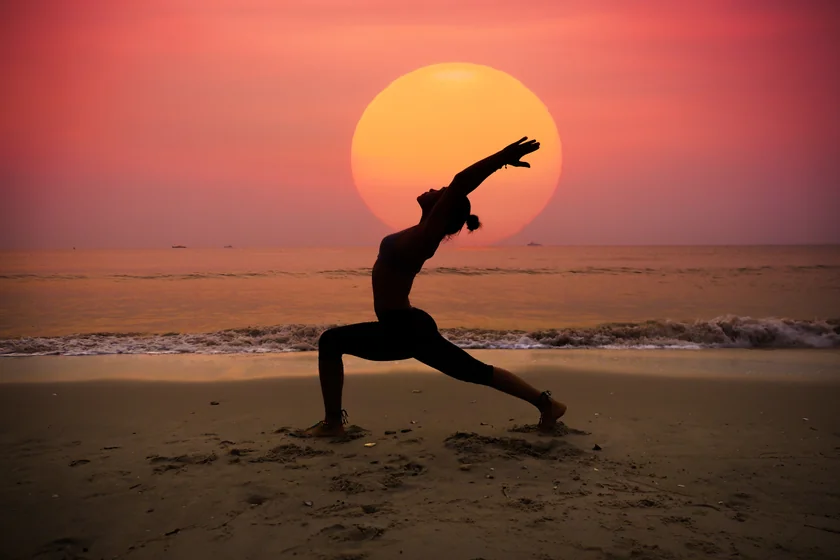
Surya Namaskar (Sun Salutations) is a dynamic and energizing yoga sequence comprising 12 flowing postures that warm up the entire body, improve circulation, and synchronize breath with movement. Pronounced “SOOR-yah nah-mahs-KAHR,” this foundational practice is one of the most widely performed sequences in yoga, known for building strength, enhancing flexibility, and awakening the mind and body.
Whether you’re a beginner or an experienced practitioner, Surya Namaskar offers a simple yet powerful way to strengthen muscles, increase mobility, and boost mental clarity — all in just a few minutes a day. It's equally effective as a warm-up, a standalone workout, or a mindful morning ritual.
Surya Namaskar: Overview & Meaning of Sun Salutations
Surya Namaskar comes from the Sanskrit words Surya (Sun) and Namaskar (Salutation), meaning “Salutation to the Sun.” The sequence’s 12 poses are traditionally associated with the 12 zodiac signs, reflecting balance and alignment with natural cycles. In yoga, the practice symbolizes acknowledging the sun as a source of energy and recognizing your own inner strength, clarity, and awareness.
The modern form of Surya Namaskar became popular in the early 20th century, largely promoted by the Raja of Aundh as a practical daily exercise. Some traditions also link it to Samarth Ramdas, a 17th-century saint who taught physical training alongside spiritual discipline.
By the mid-1900s, yoga schools across India adopted Surya Namaskar as a foundational warm-up and energizing routine. As yoga spread globally, Sun Salutations became recognized as a complete mind-body workout — accessible for beginners yet adaptable for advanced practitioners. Today, it remains one of the most universal movements in yoga, practiced in studios, homes, and wellness centers worldwide.
Incorporated into many styles of yoga, including Hatha, Ashtanga, Vinyasa, and Power Yoga, the most common forms are:
- Surya Namaskar A (Traditional): 12-step sequence
- Surya Namaskar B (Intermediate): 17-step flow with added strength poses
- Classical / Sivananda Style: Similar to A, with specific breathing patterns
- Surya Namaskar C: A more advanced variation
At a Glance
- Sanskrit Name: सूर्यनमस्कार (Surya Namaskar)
- Pronunciation: SOOR-yah nah-mahs-KAHR
- English Names: Sun Salutations, Sun Salutation Sequence
- Type: Yoga Flow Sequence (Vinyasa)
- Number of Poses: 12 (Surya Namaskar A), 17 (Surya Namaskar B)
- Level: Beginner to Advanced
- Duration: ~2–3 minutes per round
- Best Time: Early morning, empty stomach
- Main Benefits: Full-body workout, cardiovascular health, flexibility
Read our detailed guide on Suryanamaskar here!
Surya Namaskar A vs. B: Quick Comparison
Benefits of Surya Namaskar (Sun Salutations)
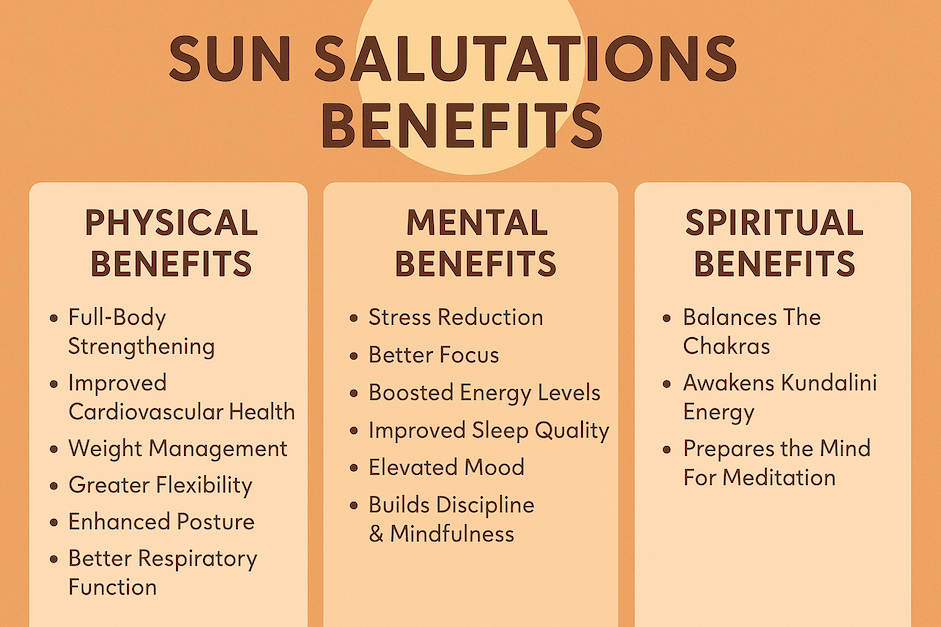
Book your free 1-on-1 session with a certified Indian yoga teacher and learn the safest, most effective way to practice Sun Salutations.
Surya Namaskar is often called a complete workout for the body and mind as it activates all major muscle groups, improves mobility, builds strength, and supports emotional balance. Some of the various benefits include:
Physical Benefits of Surya Namaskar
- Full-Body Strengthening: Each movement engages multiple muscle groups — arms, shoulders, core, back, hips, and legs — giving you a balanced, functional workout.
- Improved Cardiovascular Health: The flowing pace raises the heart rate, enhances blood circulation, and supports overall heart and lung function.
- Weight Management & Metabolism Boost: One round burns 13–15 calories, making Surya Namaskar an effective addition to any weight-management routine.
- Greater Flexibility: Regular practice increases flexibility in the spine, hamstrings, hips, chest, and shoulders.
- Enhanced Posture & Spine Health: Forward bends and backbends work together to lengthen and realign the spine, reducing stiffness from long hours of sitting.
- Digestive System Stimulation: The sequence gently compresses and stretches the abdominal area, supporting digestion and gut health.
- Better Respiratory Function: Slow, deep breathing strengthens the lungs and improves overall breath capacity.
- Hormonal & Endocrine Balance: The movement + breath coordination activates endocrine glands, promoting steady hormonal functioning.
- Improved Joint Mobility: Sun Salutations lubricate major joints, making it especially helpful for adults dealing with joint stiffness.
Mental & Emotional Benefits
- Stress Reduction: The breath-led flow activates the parasympathetic nervous system, helping relieve anxiety and tension.
- Better Focus & Mental Clarity: Synchronizing breath with movement enhances concentration and creates a meditative flow state.
- Boosted Energy Levels: Sun Salutations gently awaken the body, making them ideal for morning practice or midday recharging.
- Improved Sleep Quality: The calming rhythm of the practice helps regulate the nervous system, promoting deeper, more restful sleep.
- Elevated Mood & Emotional Stability: Regular practice releases endorphins and supports emotional well-being.
- Builds Discipline & Mindfulness: Repeating the sequence develops mental resilience and presence.
Spiritual & Energetic Benefits
- Balances All Seven Chakras: Each pose stimulates a different energy center, creating a balanced energetic flow.
- Awakens Inner Vitality (Kundalini Energy): The upward-rising movement patterns help activate dormant energy pathways.
- Connects You to Natural Rhythms: Practicing at sunrise aligns your internal clock with nature’s cycles.
- Prepares the Mind for Meditation: The flow clears mental clutter and creates a calm, focused state.
Therapeutic Applications
Surya Namaskar is often recommended (with appropriate modifications) for:
- Type 2 diabetes
- Controlled high blood pressure
- PCOS and hormonal imbalance
- Depression and anxiety
- Insomnia
- Chronic stiffness and lower back discomfort
- Osteoporosis prevention
- Menopausal symptoms
If you have an ongoing health condition or injury, consult your healthcare provider before beginning a new routine.
How to Do Surya Namaskar (Sun Salutations): Step-by-Step Guide)
Surya Namaskar is most effective when practiced with steady breath, mindful movement, and proper alignment. This guide walks you through everything you need to begin safely — from preparing your space to completing your first full round of Sun Salutations.
Part 1: Preparation for the Sequence
Although Surya Namaskar is a warm-up in itself, a short mobility routine helps prepare your joints and muscles:
1. Neck, Shoulder, Wrist & Ankle Circles
Loosens major joints and prepares the body for movement.
- Rotate each joint slowly in one direction.
- Reverse the direction and continue with smooth, controlled circles.
2. Cat-Cow Pose (Marjaryasana-Bitilasana)
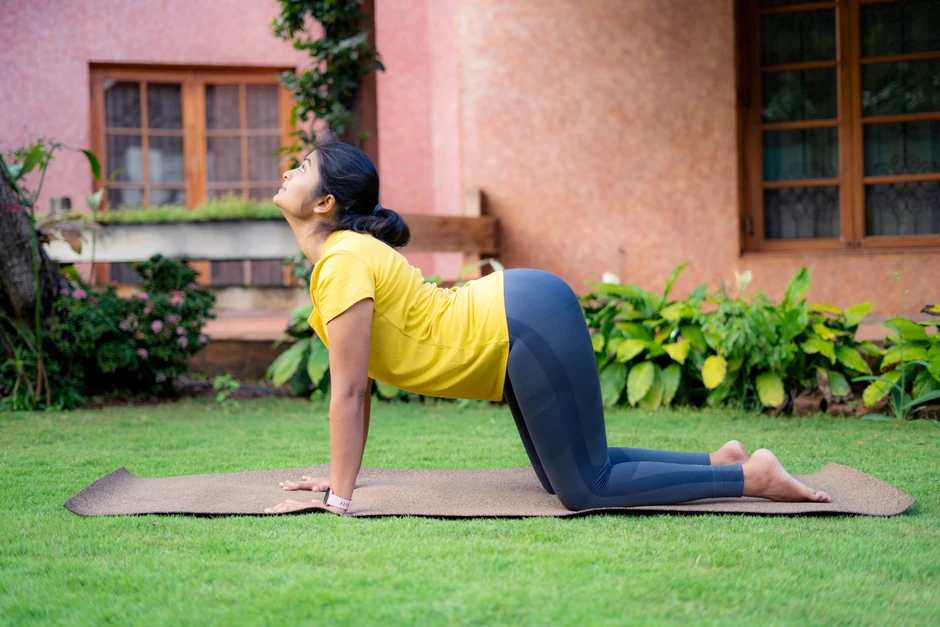
Warms up the spine and releases stiffness.
- Inhale as you lift your chest and arch your back (Cow).
- Exhale as you round your spine and draw your belly in (Cat).
- Continue flowing with your breath.
- Repeat for 10-15 rounds.
3. Downward-Facing Dog (Adho Mukha Svanasana)
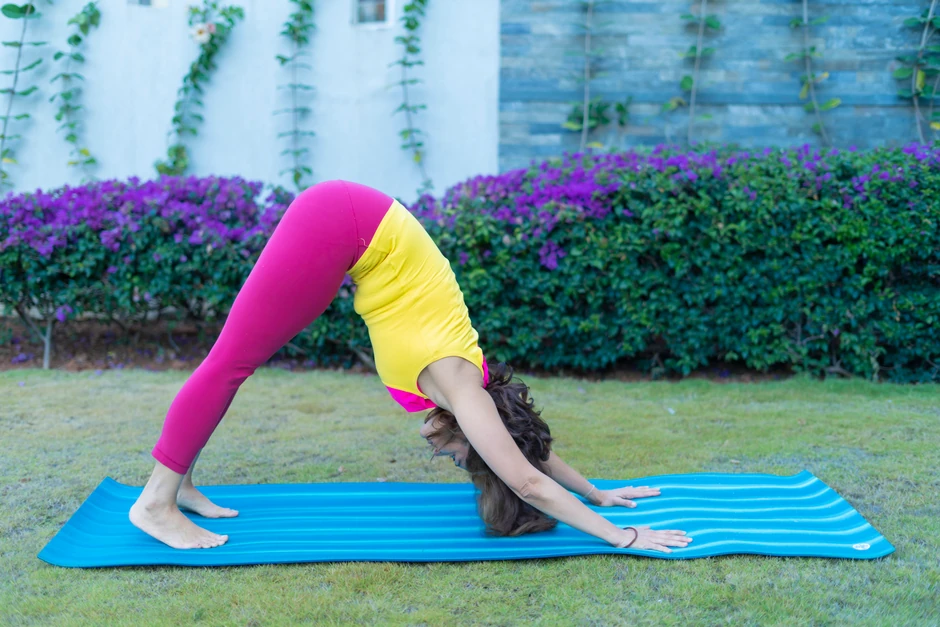
Opens hamstrings, calves, and shoulders.
- Lift hips into an inverted V-shape and press hands firmly into the mat.
- Lengthen your spine and gently pedal your heels.
- Hold and breathe steadily.
4. Standing Forward Bend (Uttanasana)

Gently lengthens the back body and releases tension.
- Hinge forward from your hips and let your arms and head relax.
- Keep your knees slightly bent if needed.
- Breathe deeply and soften your shoulders.
These movements reduce stiffness and make the sequence smoother, especially for beginners.
Part 2: Surya Namaskar A: How to Do Sun Salutations
In Surya Namaskar A, each movement follows the breath. One full round = 12 positions. To complete a full cycle, repeat once more, switching the stepping leg.
Below is the simplified step-by-step sequence:
- Pranamasana (Prayer Pose) — Exhale / Natural Breath: Stand tall at the front of your mat, feet together. Bring your palms together at your heart center. Soften your gaze and ground through both feet.
- Hasta Uttanasana (Raised Arms Pose) — Inhale: Sweep your arms overhead and gently arch back. Keep your biceps close to your ears and lengthen through the spine.
- Hasta Padasana (Standing Forward Bend) — Exhale: Fold forward from your hips, bringing your hands beside your feet. Bend your knees if needed to avoid strain.
- Ashwa Sanchalanasana (Low Lunge) — Inhale: Step your right leg back. Keep your left knee stacked over the ankle. Lift your chest and look forward.
- Dandasana (Staff Pose) — Exhale / Hold: Step the left leg back to form a straight line from head to heels. Engage your core and avoid letting your hips sag.
- Ashtanga Namaskara (Eight-Limbed Pose) — Exhale: Lower your knees, chest, and chin to the floor while keeping your hips lifted. Elbows close to your body.
- Bhujangasana (Cobra Pose) — Inhale: Slide your body forward and lift your chest using back strength. Keep shoulders relaxed and elbows slightly bent.
- Adho Mukha Svanasana (Downward Dog) — Exhale: Lift your hips into an inverted V-shape. Press your palms firmly into the mat and lengthen through your spine.
- Ashwa Sanchalanasana — Inhale: Step your right foot forward between your hands. Keep your gaze forward and chest lifted.
- Hasta Padasana — Exhale: Step the left foot forward and fold back into the forward bend.
- Hasta Uttanasana — Inhale: Stretch your arms overhead and arch gently, keeping your core engaged.
- Pranamasana — Exhale: Bring your palms back to your heart and return to standing.
How Many Rounds Should You Do?
- Beginners: 3–5 rounds (2–3 minutes per round)
- Intermediate: 12 rounds (traditional practice)
- Advanced: 54 or 108 rounds (special events/festivals)
Common Mistakes & How to Fix Them
- Holding your breath. Instead, focus on deep, steady inhales and exhales. Breath is the foundation of the flow.
- Rushing through the sequence. Consider slowing down and matching every movement to breath.
- Knee pushing past the ankle in lunges. Instead, align the knee directly above the ankle.
- Sagging in Plank Pose. Make sure you engage your core and keep a straight line from shoulders to heels.
- Using arm strength only in the Cobra. Consider pressing your hips down and lifting using your back muscles.
Master your alignment with real-time corrections. Book your free 1-on-1 session with an expert Indian yoga teacher today!
Surya Namaskar Variations
Surya Namaskar is a versatile sequence that can be adapted for beginners, intermediate practitioners, seniors, and anyone with mobility limitations. Whether you want to make the flow more accessible or more challenging, the variations below help you tailor the practice to your body and goals.
Beginner Modifications
If you’re new to Sun Salutations, slowing down and adding support can help you build strength and confidence safely.
1. Knees-Down Options
- Keep the back knee lowered in both Low Lunge positions.
- Drop your knees to the mat during Plank Pose for extra stability.
- Lower your chest and belly completely instead of doing the Eight-Limbed Pose (Ashtanga Namaskara).
2. Use Props for Comfort
- Place blocks under your hands during forward folds to reduce pressure on the hamstrings.
- Use a strap around your thighs to maintain stability during transitions.
3. Slower Pace
- Take 2–3 breaths per pose instead of moving with every inhale/exhale. This makes the sequence easier and more meditative.
4. Built-in Rest
- If you feel tired or breathless, rest in Child’s Pose between rounds.
These beginner-friendly options help you build proper alignment and strength before moving into traditional or faster-paced flows.
Surya Namaskar B (Intermediate)
Surya Namaskar B is a dynamic, heat-building variation commonly seen in Ashtanga and Vinyasa yoga. It includes 17 positions instead of 12 and introduces two key strength poses:
- Chair Pose (Utkatasana) — added at the beginning of the sequence
- Warrior I (Virabhadrasana I) — added after each lunge
This variation increases cardiovascular intensity, leg strength, hip mobility, and overall stamina. It’s ideal for practitioners who already feel comfortable with Surya Namaskar A and want a more powerful, strength-focused experience.
Here’s what the flow looks like:
- Utkatasana (Chair Pose) — Inhale: Bend your knees deeply, sit your hips back, and raise your arms overhead. Keep your chest lifted.
- Uttanasana (Standing Forward Bend) — Exhale: Fold forward from your hips, bringing your hands toward the floor. Keep knees soft if needed.
- Ardha Uttanasana (Half Lift) — Inhale: Lengthen your spine, bring your hands to your shins or fingertips to the floor, gaze forward.
- Chaturanga Dandasana (Low Plank) — Exhale: Step or jump back and lower halfway, keeping elbows close.
- Urdhva Mukha Svanasana (Upward-Facing Dog) — Inhale: Lift your chest, extend your legs, and straighten your arms as you open the front body.
- Adho Mukha Svanasana (Downward-Facing Dog) — Exhale: Lift your hips up and back into an inverted V-shape.
- Virabhadrasana I – Right Side (Warrior I) — Inhale: Step your right foot forward, pivot back heel down. Lift your torso and arms overhead, squaring your hips forward.
- Chaturanga Dandasana — Exhale: Bring hands down, step back, and lower halfway through.
- Urdhva Mukha Svanasana — Inhale: Lift into Upward-Facing Dog again with a broad chest.
- Adho Mukha Svanasana — Exhale: Return to Downward Dog.
- Virabhadrasana I – Left Side (Warrior I) — Inhale: Step your left foot forward, pivot the back heel down. Rise into Warrior I, keeping hips square.
- Chaturanga Dandasana — Exhale: Lower through Chaturanga with steady control.
- Urdhva Mukha Svanasana — Inhale: Flow back into Upward-Facing Dog.
- Adho Mukha Svanasana — Exhale: Press back into Downward-Facing Dog.
- Ardha Uttanasana (Half Lift) — Inhale: Step or jump to the top of your mat and lengthen your spine.
- Uttanasana — Exhale: Fold forward, relaxing your head and neck.
- Utkatasana (Chair Pose) — Inhale: Bend your knees and sweep your arms back overhead to return to Chair Pose.
- Return to Tadasana (Mountain Pose) — Exhale: Stand tall with arms by your sides to complete the round.
Advanced Variations
For experienced practitioners, these options add intensity and deeper engagement:
- Faster Flow: One breath per movement creates a cardio-enhancing, heated practice.
- Jump Backs & Jump Throughs: Transition quickly from forward fold to plank or into lunges.
- Arm Balance Additions: Include Crow Pose variations or floating transitions.
- 108 Sun Salutations: A traditional sequence practiced during solstices or meaningful life milestones for discipline and reflection.
Props & Accessibility
Surya Namaskar can be adapted for seniors, people with joint pain, or those with limited mobility.
- Wall Support: Great for balance during Raised Arms Pose or lunges.
- Chair-Assisted Sun Salutations: Ideal for seniors or anyone who can’t transition to the floor.
- Bolster or Cushion: Place under knees during lunges or Eight-Limbed Pose for comfort.
- Pregnancy (First Trimester Only): Move slowly, avoid deep backbends, and keep feet hip-width apart for stability. Read our detailed guide on prenatal yoga here!
These modifications make the sequence inclusive and accessible for all body types and fitness levels.
Surya Namaskar Precautions & Contraindications

Surya Namaskar is generally safe, but like any physical practice, it’s important to honor your body’s limits. If you have an existing medical condition, injury, or mobility concerns, use the precautions below to ensure a safe, sustainable practice.
Avoid Surya Namaskar if You Have:
You should avoid or postpone practicing Sun Salutations if you are experiencing:
- Recent abdominal, knee, or spinal surgery
- Severe back injury or an active herniated disc
- Uncontrolled high blood pressure
- Pregnancy (2nd–3rd trimester)
- Severe arthritis, especially in the knees or wrists
- Recent cardiac surgery or unstable cardiovascular conditions
- Acute spinal conditions, such as sciatica flare-ups
If any of the above apply, consult your healthcare provider before starting the practice.
Practice with Caution If You Have
For certain conditions, Surya Namaskar can still be practiced — but only with modifications and mindful pacing:
- Pregnancy (First Trimester): Move slowly, avoid deep backbends, and skip intense transitions. Stop immediately if you feel dizzy or overheated.
- Lower Back Pain: Avoid excessive backbending. Strengthen your core with slow transitions and always prioritize comfort.
- Wrist Pain or Weakness: Practice on fists, use wedges, or transition onto forearms in Plank and Downward Dog. Wall versions can also help reduce pressure.
- High Blood Pressure (Controlled): Move at a slow pace, avoid breath retention, and do fewer rounds. Skip fast or heated variations.
- Menstruation: Gentle Sun Salutations are safe for most people. Keep movements soft, skip deep backbends, and avoid inversions if experiencing discomfort.
- Beginners: Start with 3–5 slow rounds. Use blocks, drop knees in plank, and rest as often as needed.
General Safety Guidelines
- Practice on an empty stomach
- Warm up your joints before starting
- Keep your breath steady — never hold it
- Build rounds gradually over weeks
- Avoid pushing into pain or strain
- Stay hydrated (drink water after practice, not during)
- Use modifications without hesitation
Listening to your body is the key to a safe and consistent practice.
Surya Namaskar: Related Yoga Poses
These complementary poses pair well with Surya Namaskar, helping you build strength, improve alignment, and support a smoother flow during the sequence.
1. Warrior I (Virabhadrasana I)

Builds lower-body strength and improves hip and shoulder stability.
- Step one foot back and ground the heel.
- Square your hips forward as you bend the front knee.
- Raise your arms overhead and lengthen your spine.
2. Chair Pose (Utkatasana)

Strengthens legs, core, and back while improving balance and heat-building.
- Sit back as if into an invisible chair.
- Keep knees behind toes and chest lifted.
- Engage your core and reach your arms upward.
3. Mountain Pose (Tadasana)
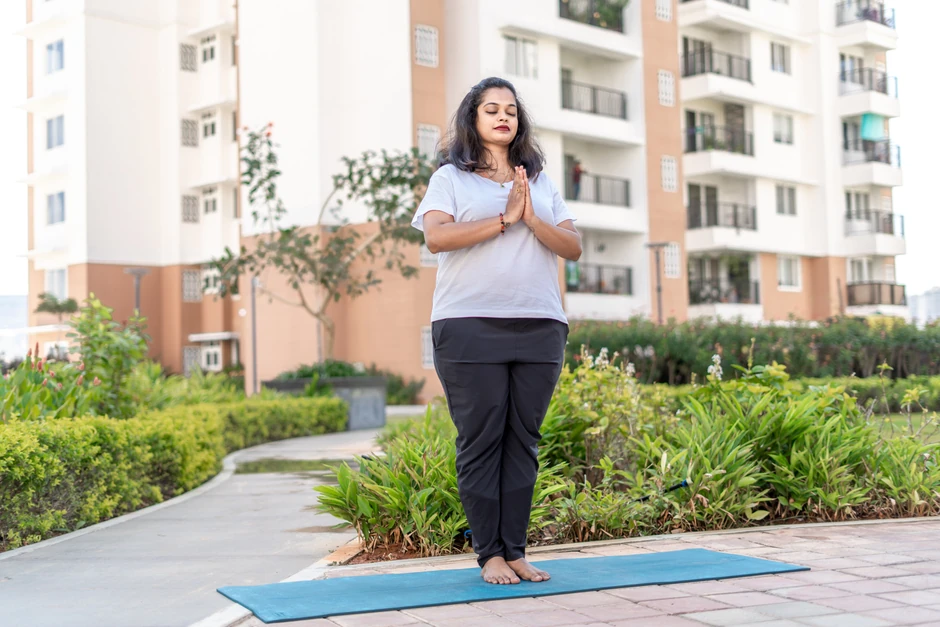
Improves posture, grounding, and body awareness.
- Stand tall with feet hip-width apart.
- Lengthen your spine and relax your shoulders.
- Lift through the crown of your head and breathe deeply.

Enjoy a Free 1-on-1 Session with a Coach!
Receive personalized guidance tailored to your unique fitness goals, live with a dedicated coach—no credit card required.
Frequently Asked Questions
- Beginners can start with 3–5 rounds to build stamina safely.
- Intermediate practitioners usually complete 12 rounds, which is the traditional standard.
- Advanced yogis may practice 54 or 108 rounds for special occasions or deeper discipline.
Increase gradually and listen to your body as you progress.
Surya Namaskar A has 12 steps and uses foundational poses, making it ideal for beginners.
On the other hand, Surya Namaskar B includes 17 steps and adds Chair Pose and Warrior I, increasing heat and strength work.
Both sequences follow the same breath-led flow, but B is more intense and suited for intermediate practice.
To practice Surya Namaskar and its variations with expert guidance, book a free 1-on-1 session today!
Each round burns approximately 13–15 calories, depending on your body weight and speed. Practicing 12 rounds can burn around 150–180 calories. A full 108-round practice may burn 1,300–1,500 calories.
It’s an efficient cardio workout that also builds strength and flexibility.
The ideal time is early morning, preferably at sunrise, on an empty stomach. This aligns your body with natural rhythms and boosts morning energy.
Yes! Sun Salutations help burn calories, boost metabolism, and build lean muscle. They reduce stiffness, improve endurance, and support overall hormonal balance.
Combined with mindful eating and consistency, they can significantly support healthy weight loss.
Absolutely! Surya Namaskar A is beginner-friendly and easy to modify. Start slowly with a few rounds, bend your knees in forward folds, and drop your knees in plank if needed.
With consistent practice, strength and flexibility naturally improve.



.webp)
%20(7).jpg)




